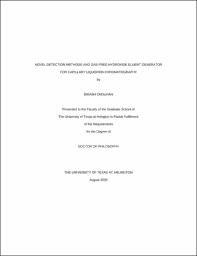
ATTENTION: The works hosted here are being migrated to a new repository that will consolidate resources, improve discoverability, and better show UTA's research impact on the global community. We will update authors as the migration progresses. Please see MavMatrix for more information.
Show simple item record
| dc.contributor.advisor | Armstrong, Daniel W. | |
| dc.creator | Chouhan, Bikash | |
| dc.date.accessioned | 2020-09-09T21:02:08Z | |
| dc.date.available | 2020-09-09T21:02:08Z | |
| dc.date.created | 2020-08 | |
| dc.date.issued | 2020-06-17 | |
| dc.date.submitted | August 2020 | |
| dc.identifier.uri | http://hdl.handle.net/10106/29368 | |
| dc.description.abstract | The light absorbed by a molecule, except for an efficient fluorophore, is mostly converted into heat, thereby causing a change in temperature. In a liquid flow system, this change in temperature results in changes in the refractive index (RI) and electrical conductivities of the solution. Photothermal measurement of optical absorption (PMOA) most often involves detecting the temperature change indirectly by measuring changes in pressure, RI, or conductivity. In a small-bore capillary, the PMOA detection technique has some distinct advantages: (a) no penalty is paid for smaller path length, (b) there are no stray light issues, and (c) a broadband light source can be used without a monochromator. In our approach, we measured the photothermal effects of optical absorption by measuring temperature change directly rather than measuring temperature-induced RI or conductivity changes. We successfully demonstrated the feasibility of this detector to be useful for liquid chromatography with both macro and micro-sized cells. The baseline standard deviation of the sensor output is 1 m°C. Chapter 2 of the thesis describes the POMA technique in more detail.
Chapter 3 of this thesis describes and compares capillary scale admittance and conductivity detection. It describes five different designs of contact conductivity cells for Open Tubular Ion Chromatography (OTIC). An admittance detector is the first choice for measurements in small diameter open tubular columns. However, at a suppressed background where the solution resistivity is very high, and the column i.d. is small (˂ 30 µm), the admittance signal is non-linear with the analyte concentration. Unlike admittance measurements, a contact conductivity detector output is linear up to a concentration of 1 mequiv/L and it is more sensitive at low concentrations in a low specific conductance, fully suppressed background. Here, we report single digit µM LODs for anions like fluoride, chloride, and nitrite.
Alkali hydroxides are more frequently used as eluent in suppressed anion chromatography as the background can be changed to pure water. However, manually prepared hydroxide solutions often contain impurities such as carbonates, chlorides, etc. Further, such solutions absorb CO2 from air leading to increased carbonate concentration. Chapter 4 of this thesis discusses about hydroxide eluent generator (EG) for open tubular ion chromatography. Such a device has an internal volume of 210 nL and generates a gas-free, pure hydroxide solution online. It is capable of carrying out chromatographic gradient separation at a flow rate of ˂ 200 nL/min without needing any split in the flow. An excellent reproducibility of the EG is apparent from the relative standard deviations of the retention times of the separated peaks (˂ 0.5 % for isocratic to ˂ 1.2 % for gradient chromatography). | |
| dc.format.mimetype | application/pdf | |
| dc.language.iso | en_US | |
| dc.subject | Photothermal | |
| dc.subject | Thermocouple | |
| dc.subject | Ion chromatography | |
| dc.subject | Nanovolume eluent generator | |
| dc.title | NOVEL DETECTION METHODS AND GAS-FREE HYDROXIDE ELUENT GENERATOR FOR CAPILLARY LIQUID/ION CHROMATOGRAPHY | |
| dc.type | Thesis | |
| dc.degree.department | Chemistry and Biochemistry | |
| dc.degree.name | Doctor of Philosophy in Chemistry | |
| dc.date.updated | 2020-09-09T21:02:09Z | |
| thesis.degree.department | Chemistry and Biochemistry | |
| thesis.degree.grantor | The University of Texas at Arlington | |
| thesis.degree.level | Doctoral | |
| thesis.degree.name | Doctor of Philosophy in Chemistry | |
| dc.type.material | text | |
| dc.creator.orcid | 0000-0001-7035-0768 | |
Files in this item
- Name:
- CHOUHAN-DISSERTATION-2020.pdf
- Size:
- 8.755Mb
- Format:
- PDF
This item appears in the following Collection(s)
Show simple item record


